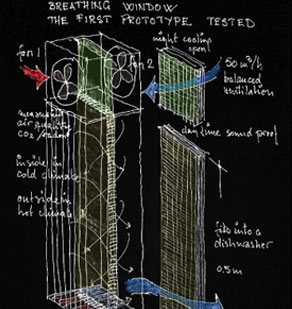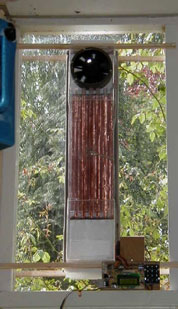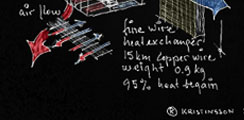|
|
|
|
|
|
|
|||||||||
|
|
|
|||||||||||||
|
|
|
|
||||||||||||
|
|
|
|||||||||||||
|
|
|
|
|
|
|
|
|
|
||||||
|
|
|
|||||||||||||
|
|
|
|
||||||||||||
|
|
|
|
|
|
|
|
|
|
|
|
|
|
|
|
|
|
|
|
||||||||||
|
|
|
 |
||||||||||
|
|
||||||||||||
 |
 |
 |
|
|||||||||
 |
||||||||||||
 |
 |
 |
||||||||||
|
|
||||||||||||
|
|
BREATHING WINDOW (Abstract PLEA 2004) The breathing window is a smart decentralized low energy ventilation in the skin (envelope) of buildings. A fine-wire heat exchanger is a unique innovation for different low temperature applications in all climates dwellings and glasshouses. It is far from easy to describe the conditions for ventilation for all types of buildings all over the world. The change from natural to forced, mechanical ventilation is fundamental. We did add to the mechanical ventilation a lot of new requirements, like heating and cooling (air-conditioning) vaporisation and dehumidifying, balanced ventilation, heat recovery, filters for the incoming (fresh) and outgoing (exhaust) air, fire compartmentalization and the installations became larger and larger all the time. The smart breathing window concept does work slightly different. The breathing window is a kind of miniature decentralized small-scale �whole-building air-conditioning?. This individualised balanced ventilation in each room at the fa?ades of the building is a kind of thinking lungs care for your health when you forget it. It measures and corrects e.g. CO2; it can measure radon and combines temperature at day- and night-time, etcetera. I will present and show the first working prototype of this breathing window, which might be the beginning of the end of traditional mechanical ventilation in many types of buildings.
|
|
STARTING WITH PRESENT INSTALLATIONS Studies on ventilation in housing, commercial and industrial building in the Netherlands show an incredible difference between the intensions and what is achieved in practice. Key-features are: concept, design, saving, execution, control, adjustment, use and maintenance. In every phase mistakes can be made and actually are being made, which in general are camouflaged by over dimensioning. In the conceptual (draft) phase the architect should design the overall indoor climate in a crosscut fashion, phrase this and explain it to the principal and the installation consultant. In practice it usually does not work this way. The help of consultants and experts is invoked, without much mutual contact.
Without affecting the layout heating, ventilation and air conditioning systems are drafted by advisors and usually concealed in lowered suspended ceilings. The internal thermal mass of the building is for a major part put out of action. Besides these lowered suspended ceilings claim 15% more building volume. In order to
conceal air ducts. The building itself should be the main part of the installations.
|
|
||||||||
|
|
||||||||||||
|
|
|
|
|
|
|
|
|
|
|
|
|
|